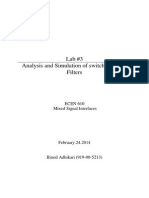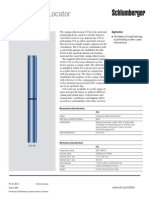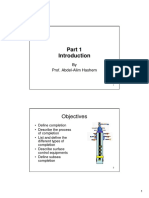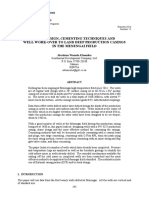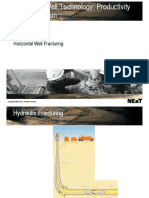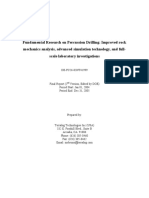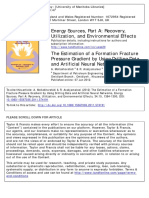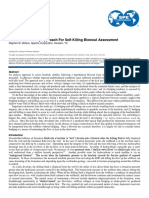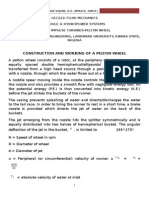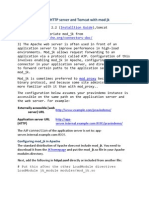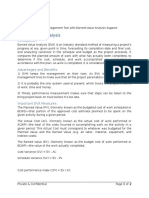Drilling and Testing of An HPHT Deep Gas Prospect From An Existing Well: Case History
Drilling and Testing of An HPHT Deep Gas Prospect From An Existing Well: Case History
Uploaded by
Ahmed GharbiCopyright:
Available Formats
Drilling and Testing of An HPHT Deep Gas Prospect From An Existing Well: Case History
Drilling and Testing of An HPHT Deep Gas Prospect From An Existing Well: Case History
Uploaded by
Ahmed GharbiOriginal Title
Copyright
Available Formats
Share this document
Did you find this document useful?
Is this content inappropriate?
Copyright:
Available Formats
Drilling and Testing of An HPHT Deep Gas Prospect From An Existing Well: Case History
Drilling and Testing of An HPHT Deep Gas Prospect From An Existing Well: Case History
Uploaded by
Ahmed GharbiCopyright:
Available Formats
MIDDLE EAST
Drilling and testing of an HPHT deep gas
prospect from an existing well : case history
By M.J. Al-Saeedi, J.R.Singh, V.S. Mahesh, Ratqa
H.S. Al-Ajmi, Kuwait Oil Company; D. Abdali
McKinnell, Total Kuwait NW Raudhatain
THE SEARCH FOR commercial NWRA-1
quantities of non-associated gas from the
Raudatain
Lower Mesozoic and Paleozoic horizons MU-12
has been an important part of the explo- MU-10
Sabriyah
ration strategy of Kuwait Oil Company Mutriba
Bubiyan
Bahrah
(KOC) over a number of years. Four deep
wells were drilled down to the Pre-Khuff
formation in the existing oilfield areas
of Burgan, Umm Gudair and Sabriyah,
before gas shows were recorded from the KM-1
Sudair formation in the fifth well, KM-1, KM-3 Kra Al Maru
in the Kra Al-Maru area (Figure 1).
Khashman
Following this result, further evidence Dharif
of gas shows were recorded from the Ahmadi
Unayzah formation in North West Abduliyah Magwa
Raudhatain-1, and strong indications of
a free gas potential were seen during Minagish
Burgan
the drilling phase on Mutriba 10, where
high-pressure influxes were encountered Existing Oil Field Umm Gudair
while drilling the Sudair formation. This
potential was borne out in the subsequent Fields Tested for Gas
Mutriba well, MU-12, which tested the first Deep Exploration Wells
measurable quantities of non-associated Figure 1: Four deep wells were drilled to the Pre-Khuff formation in existing oilfields
gas in Kuwait from the Sudair in 2004. before gas shows were recorded from the Sudair formation in the fifth well, KM-1.
Following the success in MU-12 and the
indications of gas in KM-1, it was decid- WELL DESIGN, PLANNING Several hole and casing design combina-
tions were possible. These are listed as
ed to return to the Kra Al-Maru area for The original well design for KM-3 was
follows and are shown in Figure 3:
the re-entry and deepening of KM-3. based on a “big-hole” casing program
commonly used in Kuwait for drilling Design 1
Well KM-3 was located near the crest of deep exploratory Marrat wells. Because
the Kra Al-Maru structure some 450 m of reduced pore pressure and wells • Drill 9 ¼-in. hole / Run 7 5/8-in. liner
from KM-1. Although the original drilling encountering severe loss/gain situa- to top Sudair
and evaluation of KM-3 had indicated tions in the fractured Najmah / Sargelu, • Drill 5 ½-in. hole / Run 4 ½-in. liner
some hydrocarbon potential in the a 7 ¾-in. liner is usually run to isolate from top Khuff to 300 ft above 7 5/8-
Najmah / Sargelu, logs and cores sug- the Najmar / Sargelu sequence and the in. shoe
gested that there was only limited poros- Marrat is then drilled in 6 ½-in. hole. In
ity development in the primary targeted this part of the Kra Al-Maru field, how- • Run 7 5/8-in. tie-back to surface
Marrat zones. The well was therefore ever, the pore pressures are higher and Design 2
suspended without running the liner the differential pressure between the two
across the open hole with a future pos- zones less pronounced. Therefore it was • Drill 9 ¼-in. hole / Run 7 ¾-in. liner
sible decision to deepen the well depend- possible to commingle the Jurassic for- to top Sudair
ing on engineering feasibility as well as mations in the same hole section on both • Drill 6 ½-in. hole / Run 5 ½-in. liner
the test results from MU-12, which had KM-1 and KM-3 wells (Figure 2). from top Khuff to 300 ft above 7
not been completed at the time of KM-3
¾-in. shoe
suspension. Casing designs
• Run 5 ½-in. x 7 5/8-in. tie-back (5
The subsequent engineering feasibility A review of the KM-1 offset drilling
½-in. to top of 7 ¾-in. drilling liner)
study showed that it was technically records indicated the possibility of
to surface
possible to deepen the wellbore and designing a casing program such that
that it was also economically viable the formations down to the top of the Design 3
when compared with the cost of a new Sudair would be drilled together without
• Drill RWD 9 ¼-in. x 10 ½-in. hole /
well. Therefore KM-3 was selected as a the need for an intermediate liner at the
Run 8 5/8-in. liner to top Sudair
suitable candidate for deepening to the base of the Marrat. This would allow the
Sudair formation, and detailed design final hole section to be drilled through • Drill RWD 7 5/8-in. x 8 ½-in. hole /
studies were undertaken. the prospective reservoir to a TD in the Run 7-in. liner from top Khuff to 300
base Sudair / top Khuff. ft above 8 5/8-in. shoe
90 September/October 2007 D R I L L I N G CONTRACTOR
MIDDLE EAST
Figure 2 (left): Originally, KM-3 Well Schematic - Prior to Re-entry • Run 7-in. x 7 5/8-in. tie-back (7-in. to
KM-3 was planned with a top of 8 5/8-in. drilling liner) to sur-
“big hole” casing, typical in
30-in. CSG SHOE @ 750-ft.
face
Kuwait due to high differential 24-in. CSG SHOE @ 6,228-ft.
In Designs 2 and 3, the production liners
pressures between zones, as 18-5/8-in. CSG SHOE @ 9,584-ft.
(5 ½-in. / 7-in.) have been extended to
well as low pore pressures. JURASSIC / TRIASSIC cover the previous drilling liners to allow
However, in this part of the Formations Depth (ft) 10-3/4-in. LINER TOP @ 12,577-ft.
for the production loads.
field, pore pressure is higher
13-1/2-in. CSG SHOE @ 13,188-ft. The final decision was for the adoption
and the differential pressure HITH 13,323
of Design 1. After running safety fac-
less pronounced. Therefore, tor calculations for the casing and liner
the Jurassic formations could
GOTNIA 13,643
combinations, the following casing pro-
be commingled in the same CEMENT RETAINER @ 14,883-ft.
WITH CEMENT PLUG ON TOP gram was chosen:
hole section for both KM-1
10-3/4-in. LINER SHOE @ 14,944-ft. • 7 5/8-in. liner, 70.7 lbs/ft, Q-125, pre-
and KM-3. NAJMAH 14,950
SARGELU 15,134 mium connections
DHARUMA 15,278
MARRAT 15,388
• 7 5/8-in. tie-back, 70.7 lbs/ft, T-95, pre-
mium connections
• 4 ½-in. tie-back, 18.8 lbs/ft, Q-125,
M. MARRAT 15,668
FLUID IN HOLE
premium connections
18.8 PPG OIL BASE MUD
L. MARRAT 16,338
Production Loading Safety Factor
Figure 3 (below): Of the pos- 9-1/4-in. OPEN HOLE TO 16,536-ft.
sible design combinations, The next main decision point was the
Designs 2 and 3 featured
MINJUR 16,985 cementation of the production tie-back
casing in relation to the production loads
extended production liners.
generated under the tubing leak sce-
Design 1 uses minimum cas- JILH 17,570
nario. The criteria taken were: a Sudair
ing requirements, with liners pore pressure of 19 ppg, gas to surface,
run in standard size holes JILH SALT 18167
and a supporting gradient of 8.4 ppg
without under-reaming or (water) for the cemented tie-back.
RWD. This design also allows
SUDAIR 18,695
With these criteria, it was not possible
for the collection of most of KHUFF 19,005
to use an overbalanced completion fluid
the well data KOC required.
SCHEMATIC NOT TO SCALE
with a tie-back cemented to surface and
DEPTHS ARE IN FT-DD
KM-3 Casing Design 1 Casing Design 2 Casing Design 3 still maintain a 1.2 safety factor for burst.
Formation Depth (ft)
Therefore the design loading was run
with a series of underbalanced completion
fluid weights and cemented lengths. 11.2
ppg calcium chloride brine was selected,
which allowed the maximum length of
production tieback to be cemented.
BOP / wellhead rating
5-1/2-in. x 7-5/8-in. 7-in. x 7-5/8-in.
X-OVER X-OVER
The pore pressure of 19 ppg considered for
7-5/8-in. TOL 7-3/4-in. TOL 8-5/8-in. TOL
the Sudair resulted in a Production MASP
10-3/4-in. SHOE 10-3/4-in. SHOE 10-3/4-in. SHOE
of 15,970 psi. The drilling loading MASP,
NAJMAH 14,950 based on 2/3 void situation, was 10,450 psi.
Given these figures, it was planned
9-1/4-in. HOLE 9-1/4-in. HOLE 9-1/4-in. x 10-1/2-in. to drill the well with a 15,000-psi WP
RWD wellhead and BOP system (4-Ram), and
increase to 20,000-psi WP for the tubing
head and Xmas tree assembly. Likewise,
the test tubing, downhole packers and
4-1/2-in. TOL 5-1/2-in. TOL 7-in. TOL equipment were rated in line with antici-
pated Sudair pressure.
SUDAIR 18,695 7-5/8-in. SHOE 7-3/4-in. SHOE 8-5/8-in. SHOE
Well material and equipment planning
5-1/2-in. HOLE 6-1/2-in. HOLE 7-5/8-in. x 8-1/2-in. Following the establishment of the major
RWD
design points, the long lead equipment
items were identified and ordered, and a
KHUFF 19,005
basis for the detailed well planning was
4-1/2-in. SHOE 5-1/2-in. SHOE 7-in. SHOE
established. The major items included:
92 September/October 2007 D R I L L I N G CONTRACTOR
MIDDLE EAST
pressures. The properties of the diesel oil-based muds pro-
Hole Size 9-1/4-in. 5-1/2-in. grammed for the sections are given in Table 1.
Formations Minjur / Jilh Sudair / Top Khuff
Well test phase
Pore Pressure 18.2 - 18.7 ppg 18.7 - 19.5 ppg
An underbalanced fluid was recommended for the packer fluid
Mud Weight 18.6 - 18.9 ppg 19.2 - 19.6 ppg during the well test period. Following the casing design calcula-
Plastic Viscosity tions, 11.2 ppg calcium chloride brine was selected. Planning
40 - 55 45 - 60 for this type of fluid included the provision of mixing facilities
(PV) at a central mud plant, separate frac tank storage at rig site
Yield Point (YP) 4 - 8 lb/100-ft2 4 - 6 lb/100-ft2 and the establishment of a fluid clean-up and displacement
planning.
PoM 2.5 - 3.0 cc 2.5 - 3.0 cc
HPHT cementing
HPHT Fluid Loss 2.0 - 3.0 cc 2.0 - 3.0 cc
Water 1.0 - 2.0 % 1.0 - 2.0 % The pore pressure regime predicted for this re-entry well dictat-
ed the need for heavy slurry formulations in the range of 19.5 to
Table 1: The main drilling fluid properties were similar for the 20.0 ppg. With this HPHT environment, particular attention was
two drilling phases. The diesel-based muds differed due to lith- paid to the design of the slurries. The cementing design verifica-
ologies and pore pressures. tions were carried out at the North Sea laboratory of the cement-
ing contractor, and KOC employed the services of their IOC con-
• 7 5/8-in., 70.7 lbs/ft, Q-125/T-95, premium thread liner/tie- sultant to verify and comment on the cementing job proposals.
back casings
The key elements of the cementing design proposals are dis-
• 4 ½-in., 18.8 lbs/ft, Q-125, premium thread liner casing cussed below:
• 3 ½-in., 15.8 lbs/ft, T-95, premium thread tubing and pup Temperature
joints
Accurate estimation of bottomhole circulating temperature
• 7 5/8-in. and 4 ½-in. liner hangers with top liner packers and cement slurry temperatures was a requirement for proper
slurry design. The usual API schedules can give inaccuracies
• 9-in. nominal 20,000-psi tubing head and Xmas tree
at extreme conditions; therefore, in addition, a temperature
assemblies complete
simulation program was run to evaluate the results.
• 7 5/8-in., 15,000-psi permanent packer. Slurry designs
These special order items were subject to individual tracking The main consideration for the slurry was the stability at bot-
throughout the manufacturing and delivery process. tomhole conditions. At these higher temperatures, the retarder
system is critical. Therefore it was important to ensure that
DETAILED ENGINEERING any variations in retarder concentrations or temperature
Drilling Fluids would not be detrimental to the slurry’s thickening time, com-
pressive strength or other properties.
The drilling fluids program adopted for this well had to be
tailored to handle formations with high pore pressures and Spacer design and volumes
complex lithologies. In the Kra Al-Maru area, KOC finds some The spacer stability was checked at downhole conditions,
of the highest pressured zones in Kuwait, with mud weights especially as it was heavily weighted with solids (barite and
sometimes approaching the limits for barite weighted diesel manganese dioxide). The spacer volumes were recommended
oil-based mud systems. to be larger than those used for standard jobs, given the close
For the re-entry and the two drilling phases, a high-weight oil- weight difference between the different fluids. The spacer sys-
based mud system was programmed with a clear fluid calcium tem was designed according to an “Erodibility Concept”; there-
chloride brine planned for the well test operations. Details on fore the spacer was designed to be more viscous than the mud
the individual phases are given below. and less than the slurry.
Well re-entry Placement considerations
In an HPHT environment, it is common to have a very narrow
During the drilling of KM-3 original hole through the Jurassic
ECD window between pore and fracture pressures. In order to
zones, the mud weight used varied between 18.6 and 18.8 ppg.
prevent losses and gains, HPHT cement job simulators were
It was planned to re-enter the well and ream down in stages,
used with accurate rheological data to determine optimum
circulating out the old mud with new fluid weighted between
rates for mixing and displacing. This HPHT rheometer was
18.5 to 18.7 ppg, raising the weight gradually as hole condi-
only available outside Kuwait, so the spacer and slurry designs
tions dictated. The unknown element was the amount of barite
were prepared well in advance.
settlement that may have taken place, and consideration was
given to separating displaced fluids for eventual return to the Cement quality
central mud plant for reconditioning.
For HPHT applications, good quality API Class G cement is a
9 ¼-in. / 5 ½-in. hole sections fundamental requirement. In KM-3, a recognized cement brand
previously used for HPHT cementing in the North Sea and
The main drilling fluid properties for the two drilling phases
Kuwaiti fields was programmed, blended with 35% silica flour
were similar, with some differences due to lithology and pore
for high-temperature application. In addition to the normal API
94 September/October 2007 D R I L L I N G CONTRACTOR
MIDDLE EAST
testing, all the cement batches needed for the jobs were identi- section, drilled with an 18.6 ppg mud, was estimated to
fied and reserved and their quality individually controlled. be from 316 to 286 HP, at an average surface pressure of
4,100 psi.
Cement additives
• With the use of oil-based mud and given that the turbine
Based on North Sea and Kuwaiti well experience, selected is of all-metallic construction, the turbine was considered
additives were chosen for this well. The properties required to have much greater reliability with longer running hours
in the slurry were: good stability, low rheology, good fluid loss than the use of elastomer stator PDMs.
control, good retarder response, fast compressive strength
development and good mixability. • The turbine is not affected by stalling.
The choice of synthetic retarders was important for this HPHT • Depending on the mud weight and rheology, the turbine
cementing. They have a more linear response and a greater power section (i.e., number of turbine stages and blade
tolerance to changes in bottomhole circulating temperature type) can be modified for optimum performance.
than do lignosulphonate systems.
To obtain the maximum benefit from the output parameters of
One of the most important issues was the quality control of the the turbine, the bit supplier worked with the motor contractor
additives. All of the chemicals reserved for the job had a single to enhance the design of the PDC bits to provide resistance
batch or lot number, which simplified the lab testing and gave to abrasive wear at the higher turbine RPMs. The stabilizer
confidence on the behavior of each pattern used was a fully packed
additive. KM-3 configuration to provide optimum
Days from Re-entry Vs. Depth
stability and the transmission of
Fluids recommendations
16,500
WOB without buckling.
7 8-in. liner
5/
Slim-hole coring
The planned slurry weight was
expected to be 19.5 ppg, with a With the chosen casing design,
spacer weight of 19.2 ppg. the hole size through the reservoir
was restricted to 5 ½-in. To core
Lab test results gave a thickening in this size of hole, the choice was
time of about 10:00 hrs with a fluid 17,500
between a 4 ¾-in. barrel, which
loss of under 30 cc / 30 min. would recover a 2 5/8-in. core, or
a slim hole 4 1/8-in. barrel, which
Measured Depth (ft.)
4 ½-in. liner KM-3 Re-entry
(Actual) would cut a 2-in. core. The two
The slurry design was similar to problems with the larger barrel
KM-3 Re-entry
the 7 5/8-in. liner but somewhat (Proposed) were:
heavier at 20.0 ppg, and the spacer
weight 19.8ppg. 18,500
• Not being able to fish the barrel
with an exterior catch overshot.
Lab test results gave a thickening
time of about 9:00 hrs with a fluid • Use of specially manufactured 5
loss of under 30 cc / 30 min. ½-in. core heads.
Actual slurries used were heavier Slim-hole motors
than those planned due to forma- In order to complete the drilling
tion pressures. 19,500 phase of the well, it was necessary
Turbodrilling
0 30 60 90 120 150 180
to clean out inside the 4 ½-in. liner
Days from Re-entry
after the cementing operation. On
In the offset wells for KM-3, the Figure 4: The well was re-entered and drilled to TD in 79 the previous deep well, MU-12,
Minjur and Upper Jilh formations days, versus the planned 54 days. slim-hole motors were used with
were drilled with various bit types varying degrees of success. For this
using a rotary BHA with low overall ROPs. For KM-3, it was well the drill string design was thoroughly studied with regard
decided to investigate the possibility of using the latest turbodrill- to torque ratings and the possibility of recovery of any fish.
ing technology in an effort to improve the drilling performance.
The motor specifications were:
One area where the new design of advanced turbodrill motors
has been used is in the drilling of hot, deep boreholes. In the • Nominal diameter – 2 7/8-in.
Gulf region, such turbines have been successfully run in deep • Maximum torque – 900 ft-lbs
hole applications in fields in Abu Dhabi and Oman.
• Maximum flowrate – 120 gpm
In the case of KM-3, the design of the latest high-temperature • Motor head features - double check valve, hydraulic dis-
straight hole turbines gave the following advantages over stan- connect, dual circulating sub.
dard rotary or PDM drilling:
The drill string for use inside the 4 ½-in. liner was 2 3/8-in. drill
• The turbine is an all metallic tool with diamond bearings tubing, 5.3 lbs/ft, CS-Hydril connection. The torque rating for
and thus is unaffected by high downhole temperatures, this pipe was 1,500 ft-lbs. A selection of 3 ½-in. fixed cutter
such as the 300°F expected on KM-3. bits/mills were ordered for the clean out work.
• The present design of 6 5/8-in. turbodrill has a higher HP Two related technical problems were present with this drilling
power output than earlier tools. Output predicted for the assembly; flow rate and mud weight. It would be critical to con-
96 September/October 2007 D R I L L I N G CONTRACTOR
MIDDLE EAST
trol the mud weight value and pump output within a range that Attempts were made to continue drilling while combating the
was suitable for the motor to drill effectively. loss / gain cycles. At 18,331 ft with partial losses at 30 bbl/
hr and a mud weight of 19.6 ppg, it was necessary to trip the
DRILLING OPERATIONS string to remove the turbine. To control the formation flows,
the mud weight was raised in stages to 19.9 ppg. On attempt-
The well was re-entered and drilled to TD in 79 days against ing to trip, the well was not taking the correct amount of fluid,
a planned figure of 54 days. The drilling curve is illustrated in therefore the drill pipe volume was bull-headed and 20.5 ppg
Figure 4. kill mud pills pumped into the annulus during the rest of the
trip to control this tendency to flow.
9 ¼-in. Phase
As it was not possible to continue drilling with this high mud
Re-entry and clean-out of original hole
weight, it was decided to attempt to stabilize the lower part
The initial operation of cleaning out the cement and suspen- of the hole by squeezing cement. A cement retainer was run,
sion plug to 10 ¾-in. shoe at 14,936 ft required excessive ream- and 300 bbl of 17 ppg cement was squeezed into the open
ing from about 7,000 ft onwards; probably due to barite sag- hole.
ging as the mud left in the original hole was not treated with
Following a negative test to 19 ppg, the mud weight was
viscosifiers for long-term suspension.
reduced to 19.5 ppg, and the hole washed and reamed to
As the 9 ¼-in. open hole was cleaned to 15,419 ft, gas levels 16,400 ft, where a 7-bbl gain was registered on a flow check
increased and the mud weight increased to 18.9 ppg. During (SIDPP 810 psi, MWE 19.95 ppg). The mud weight was raised
the subsequent flow check the well was found to be flowing and to 19.9 ppg, and washing and reaming continued up to 18,331 ft
on resuming circulation, losses occurred. Therefore, LCM pills through patches of firm cement.
were pumped to plug the loss zones and the mud weight was
New hole was drilled to 18,390 ft, where the well again flowed
gradually raised in attempt to stop the flow on the annulus.
at 50 bbl/hr. The mud weight was raised to 20.2 ppg, and the
This loss/gain cycle continued during the reaming of the pre- well again went into a loss /gain cycle. At a final mud weight of
viously drilled open hole down to the original TD of 16,662 20.4 ppg, the well was put on losses to trip.
ft. At this point, mud weight had been increased to 19.2 ppg.
With the well in this critical state at the limits of the conven-
Attempts were made to deepen the hole using this mud weight,
tional mud weights and with the experience from well KM-1,
but drilling was stopped at 16,700 ft due to further flows and
where Minjur to top Khuff were drilled in the same hole size,
losses. At this point, total fluid losses had increased to 7,490
the decision was taken to run the 7 5/8-in. casing earlier than its
bbl and total LCM pumped was 1,960 bbl.
programmed setting depth. It was further evaluated that this
Mud weights were now much higher than those seen during the would at least secure the Jurassic objectives, while giving a bet-
original drilling and, given the narrow range between loss and ter chance to reach the deeper horizons.
gain, a decision was taken to squeeze cement across the entire
This salt water flow from the Jilh salt / limestone sequence
open hole section to try and seal off the problem areas.
was not seen on the offset well KM-1. Total losses since prob-
200 bbl of 19.5-ppg cement was squeezed through a retainer lems were encountered in the Jilh Salt sequence were 5,140 bbl
set above the 10 ¾-in. shoe into the open hole, the mud weight
Running the 7 5/8-in. liner
cut to 19 ppg and firm cement cleaned out to a depth of 15,355
ft, following which the hole was washed / reamed to the exist- The 7 5/8-in. liner string was run with the well in a static condi-
ing TD at 16,700 ft with no further losses or gains. tion. There were no returns on breaking circulation with the
liner shoe at the 10 ¾-in. shoe, or at the setting depth.
Drilling to the Jilh Salt Formation
The 7 5/8-in. hanger did not set, and the string was cemented on
Rotary drilling continued with a PDC bit to the top of the
bottom with 100 bbl of spacer and 150 bbl of 20.5 ppg cement.
Minjur formation (16,985 ft), where penetration rates came
The cement weight was heavier than first proposed, but the
down from 7 ft/hr at the start of the Minjur to 2 ft/hr by 17,150
properties were fully tested prior to the job. There were no
ft, with the formation consisting of firm shales. The penetration
returns while circulating or cementing with total formation
rates continued to remain low, even when the mud weight was
losses being 1,032 bbl. The liner top packer was successfully
lowered to 18 ppg above the Jilh formation at 17,570 ft, where
set after the cement displacement.
the estimated pore pressure had reduced to 17.6 ppg. With
such low ROPs, it was decided to pick up the turbine. The mixing of the slurry was as per the pre-job simulations,
but one point of concern was the high pump pressures needed
A 6 5/8-in. turbine was run with a new 9 ¼-in. PDC bit. Initial
when attempting to reverse out after the job. This had also
penetration rates of 6 ft/hr was reduced to 4 ft/hr, and a trip
been seen on the previous two cement squeeze jobs. After
was made to check the condition of the bit, which was only 5%
investigation, it was recommended for future jobs to change
worn. A different design PDC bit was picked up, and drilling
the spacer chemical and to use a drill pipe wiper ball to
rates increased, from 6 ft/hr up to a maximum of 15 ft/hr at the
remove any residual cement from the DP.
top of the first Jilh salt (18,167 ft).
5 ½-in. phase
Drilling continued to 18,292 ft, where a kick was encountered
and was shut in with 1,540 psi on the drill pipe (equivalent to Drilling to core point in the Sudair
19.6 ppg mud). On first circulation, the mud weight was cut to
16.5 ppg with the influx being salt water. After the second circu- Tieback of the 7 5/8-in. liner to surface, prior to drilling out, was
lation with 19.3 ppg in and out, the BOP was opened and the well then discussed. The vulnerability of the 10 ¾-in. casing due to
circulated at 300 gpm with an ECD at 20.3 ppg, which held the the number of rotating hours, was weighted against the flow /
formation. standpipe pressure restrictions imposed by using a full 3 ½-in.
98 September/October 2007 D R I L L I N G CONTRACTOR
MIDDLE EAST
drill pipe string to surface. In the end, the condition of the 10 Running 4 ½-in. liner and 7 5/8-in. tie-back
¾-in. was considered acceptable for drilling to continue.
The 4 ½-in. liner string was run with partial to no returns. The
With the shoe integrity checked up to an EMW of 20.1 ppg and liner was hung and cemented with 35 bbl of 20.0 ppg cement
a 19.6 ppg mud weight, 5 ½-in. hole was drilled to 18,512 ft, slurry. The cement plug was not bumped, and no returns during
where losses were encountered at 60 bbl/hr in the lower part of the job. On attempting to pull out the liner setting tool, there
the Jilh formation. were indications that the liner had not been released. When the
string was pulled to surface, the liner hanger was found to be
The open hole was cemented through a 7 5/8-in. cement retainer, held by the pack-off bushing dogs, which had not released.
and cement drilled out with the lower mud weight of 18.8 ppg.
Hard cement was reamed out during the clean-out trip to the
Drilling continued without further incident into the Sudair for- liner TD at 19,050 ft. On observing the well, it was found to be
mation (top at 18,695 ft) to a core point at 18,730 ft. flowing at 90 bbl/hr; therefore attempts were made to put the
Coring and drilling to TD well on losses by pumping high weight slugs, which resulted
in partial returns of 78%. The well continued to flow, and the
A 60 ft x 4 ¾-in. core barrel was made up with a 5 ½-in. PDC mud weight was raised in stages to 20.1 ppg with mud losses
corehead, and six cores were cut through the Sudair into the of 50%. 22 ppg slugs were again bullheaded into drill pipe and
top Khuff to 19,045 ft. The mud weight at the start of the sec- annulus to trip the pipe.
tion was 18.8 ppg, and this was raised to 19.2 ppg following an
The same liner hanger was reconditioned and the shoe modi-
influx with increase in gas count plus chlorides during the cut-
fied with v-set blades on the nose, to aid release. The 4 ½-in.
ting of core No. 5.
liner was re-run, with no returns and fluid level static at the
A 5 ½-in. PDC bit was run, and drilling continued in the Khuff wellhead. The liner was released on bottom and cemented with
to 19,057 ft, where losses started at 30 bbl/hr. An LCM pill was 35 bbl of 20.5 ppg cement. Again the plug was not bumped, and
pumped, and the section drilled to 19,077 ft, where losses again there were no returns during the job.
occurred. At this point, drilling was shut down to change out
To ensure isolation, a 7 5/8-in. cement retainer was set at
the wash pipe. During the repair process, the well was closed-
17,706 ft and the top of the liner squeezed with 30 bbl of 20 ppg
in, and 800 psi pressure was recorded on the annulus.
cement. After cleaning out and polishing the PBR, a liner top
The influx was circulated out, and the mud weight raised back packer was run and set, and negative tests were carried out
to 19.2 ppg. On attempting to POH with the string, the well to 10.5 ppg EMW at the top of the 4 ½-in. liner, and to 16 ppg
started to flow (ECD during the drilling being estimated at 19.5 EMW on the 7 5/8-in. liner lap. The mud weight was reduced to
ppg). The well was closed-in, and the mud weight raised in 16 ppg, and the 7 5/8-in. casing tie-back was run and cemented
stages up to 19.8 ppg. with 180 bbl of 16.5 ppg cement.
The hole was then reamed down to 19,053 ft, with high torque End of well operations
and losses (17% returns). LCM pills were pumped, but the loss- Clean out and preparation for Testing
es increased with only 5% fluid returns. The well was observed
as static at this point, and the drill string pulled out to the cas- A 3 ½-in. mill plus 2 7/8-in. slim-hole motor were run on 2 3/8-in.
ing shoe. After checking for flow, the bit was pulled to surface, drill tubing, and the 4 ½-in. liner was cleaned out to 18,912 ft,
with the mud level not visible during the trip. where the wiper plug assembly was tagged. Given the limited
performance of the motor to this point, the mud weight was
With the hole again in an unstable condition, a further squeeze lowered from 16 to 14 ppg in an attempt to improve the motor
with acid soluble cement (17.5 ppg) was carried out through parameters. Two further mill runs, including a change of
a retainer. On drilling out the cement, flows and losses were motor, were made but, it was not possible to clear further than
again evident, and the mud weight was once more increased to 18,915 ft; therefore the motor was laid down.
19.9 ppg due to a CO2 influx.
It was decided to try a slightly reduced diameter mill (3 ¼-in.
The well was put on losses by bull-heading 22 ppg mud slugs OD) and to run it on a rotary assembly. A close watch was paid
down annulus and drill pipe, and the bit was pulled to surface. to the torque levels during drilling given the use of the 2 3/8-in.
Once on surface, it was found that the bit had lost all three drill tubing.
cones. In order to re-stabilize the well, a second cement retain-
er was set, and 100 bbl of 17.5 ppg acid soluble cement was The plug assembly was drilled up, without undue torque prob-
squeezed below. On pulling out the string, it was found that the lems and the cement plus shoe track cleaned out to a plug
drag blocks and spring from the retainer setting tool had been back TD of 19,040 ft. This left a remaining length of 10 ft of
left in the hole, therefore a 5 3/8-in. mill and junk sub were run cement above the liner shoe. It was a requirement to drill up
to clean out the junk and retainer. this much of the shoe track as the zone of interest extended
down to the top of the Khuff formation.
The well was finally cleaned out to a plug back depth of 19,050
ft, which was chosen to be above the suspected loss zone in the The 4 ½-in. liner shoe was negative tested to 10.5 ppg EMW,
Khuff formation. On circulating prior to logging, the well again followed by a positive pressure test of the entire column.
started to flow. The well was closed-in, and mud weight was The drilling mud was displaced to brine in several circulation
increased in stages to 19.8 ppg, where losses started. Due to steps, due to the circulation pressures involved. First the oil-
subsequent flow, the weight was raised further to 19.9 ppg, by based mud was reduced in density from 14 to 12.5 ppg. This
which time losses had increased, with only 40% returns. At this was followed by the circulation of scavenger / surfactant pill
stage, the decision was taken to cancel the open-hole logs and train to remove the oil base mud ahead of the 11.2 ppg calcium
to immediately run the 4 ½-in. liner (Figure 5). chloride brine. An extended observation period was applied
to check the well for any flow back. The fluid movements due
100 September/October 2007 D R I L L I N G CONTRACTOR
MIDDLE EAST
to temperature effects were plotted in order to check for any of well site supervision and good cooperation of the rig con-
traces of abnormal fluid flow. tractor.
Cased hole logs were then run and preparations made for test- Utilization of the latest technology and products in HPHT
ing. It was noted that the CBL log showed fairly good cement cementing gave good results during the slurry mixing and dis-
across the 4 ½-in. liner, particularly around the liner shoe and placement, the only problem being the reaction of the spacer
above the zone to be perforated. during primary and squeeze cementing.
The use of turbine and slim down-
WELL TESTING KM-3
Pore Pressure & Mug Weight vs Depth hole motor technology gave mixed
The planning of a well test with 16,500
results. The turbines were reliable
20,000-psi rated equipment was and gave some increase in the ROP.
as challenging as the design and However, there were some limita-
procurement for the drilling phases tions with the slim-hole motor per-
of the well. The specialized equip- formance.
ment necessary for such HPHT
testing is fairly unique, and only a The extended testing of a deep gas
few sets are available worldwide. Mud Weight zone with 20,000-psi rated equip-
KOC decided early in the planning
17,500
Pore Pressure ment and the recovery of down-
for this well that a dedicated team hole pressures, rates and samples
has fully proved the application of
Measured Depth (ft.)
should be established to be respon-
sible for the testing aspects. this specialized well test technol-
ogy for other deep gas wells in
KOC organized well test specialist Kuwait.
support for the programming and
supervision of the tests with the This was the first extended test of
assistance of their IOC engineering
18,500
a deep gas zone in Kuwait, and it
consultant. These technical experts showed that the well has a poten-
were integrated into the team once tial to produce commercial quanti-
the drilling phase got under way, in ties of gas and condensate.
advance of the testing period. Their This successful deepening and
work scope was split into a pre- testing of an existing well in a
planning / design phase followed by severe pressure environment has
an operational phase. 19,500 provided valuable lessons that can
be applied to the drilling of future
14 15 16 17 18 19 20 21 22
Well test design Pore Pressure & Mud Weight (ppg)
wells of this type. These lessons
The DST test string design was Figure 5: Upon encountering losses, the well was and recommendations include the
based on objectives of the well test, plugged back to 19,050 ft. Upon circulating, the well following points:
plus the experience learned from began to flow. Mud weight was increased until losses Well design
the 20,000-psi well tests carried started. This prompted the decision to cancel logs and
out on well MU-12 and from HPHT • Due to a change in pore pressure
immediately run the 4 ½-in. liner.
testing globally. The general system regime and risk of heavy losses in
design was that of a tapered string, with the DST / TCP BHA the Khuff, plus possible well control with the Sudair, it is
stabbed through a permanent packer. necessary to isolate the Sudair from the Khuff with a dedi-
cated casing string.
Results and performance
• Well designs for these HPHT prospects should be planned
In the absence of any defined logging information, the decision with a contingency casing string. In the case of unpredict-
was taken to perforate and test for hydrocarbon prospects the ed high pressures or reduced loss / gain window, a string
available footage in the Sudair and top Khuff. may have to be run earlier than programmed.
After acid stimulation, the well was cleaned up and flow-tested Well material, equipment planning
on various choke sizes. This clean-up was hampered by the
salt precipitation and plugging of tubing and surface chokes. • After the completion of detail design stage, a long-term
planning and follow-up procedure should be put in place to
track the special order material items.
CONCLUSIONS
The deepening of KM-3 has been highly challenging due to • Well test equipment rated to 20,000 psi needs to be orga-
the differences in lithology and pressure regime from those of nized and committed for early in the well preparation
the offset well KM-1, the pressures encountered during drill- phase, followed by regular contact with provider.
ing being higher than those predicted, a very narrow window Drilling fluids
between gains and losses.
• Suspended wells programmed for eventual re-entry should be
Even with these associated risks and problems, the well has suspended with OBM treated to packer fluid specifications.
been deepened to target and successfully tested in less time
and with less expense than drilling a new well. This was pri- • Heavy losses in both hole sizes. General LCM mix gave
marily due to the thorough engineering and planning works partial / temporary seal, investigations to be made into
that were undertaken early in the project, plus the high level advanced polymeric based LCM technology.
102 September/October 2007 D R I L L I N G CONTRACTOR
MIDDLE EAST
HPHT cementing
• For squeeze jobs using high-density cements and spacers (over
18.0 ppg), use compatible spacer chemical with rig supplied
barite. Spacer volumes to be increased to clean drill pipe.
• Use drill pipe wiper ball to remove any residual cement from
the DP during cement squeeze jobs.
Downhole motors and rental tubulars
• Turbodrills to be considered for future drilling of deeper
formations. They gave ROP increases compared with rotary
assemblies, with no equipment failures or evidence of down-
hole vibration. A circulation sub should be run to allow
pumping of coarse LCM.
• Found 2 3/8-in. CS-Hydril tubing suitable for rotation and
cleared plugs and cement inside the 4 ½-in. liner.
Liner hangers / tieback
• Procedure to be developed in conjunction with supplier for
effective disengagement of liner running tool after cementing
to ensure deep set, lightweight liners, in heavy mud weights
do not travel up.
Testing
DST and TCP
• Effective makeup OD of eccentric tools must be verified by
the supplier with reference to the limiting string OD that can
be run in the wellbore (i.e., vendors gauge carrier could not
be run due to an oversized effective OD).
• DST tools are designed to stay in the hole for relatively short
testing duration (within a month). In the case of KM-3, DST
tools were in the hole for over 28 days, and they all functioned
as designed. Contingency plans must be considered in case the
tools are to be kept in the hole for longer. In this well, minimum
downhole tools were used and two reversing valves were run.
• Designing the job with bigger ID permanent packer would:
o Allow the use of bigger OD firing head and redundant firing
head.
o Provide more flow area through the packer.
Surface testing
• Salt production at surface affected the stability of flow rate
measurements. Amount of salt produced at surface was
directly proportional to choke size. Technologies to be inves-
tigated to enable uninterrupted well production testing from
salt saturated formations without risk of salt plugging in sur-
face lines and production tubing.
Acknowledgements
The authors wish to express their appreciation to Kuwait Oil Company for
permission to publish the information on Kra Al Maru 3 and would like to
thank all who contributed to the KM-3 Project, including Deep Drilling I
Team members, especially field personnel; Red Roberts and Paul King (KOC
Senior Supervisors), Galen Heth and Bill Wagstaff (KOC Supervisors),
KOC Exploration Teams, KPD Rig-24 crew, MI mud engineers, Halliburton
Cementing Team, Sperry Sun Mud Logging engineers, Schlumberger Well
Test Team and Axis Well Technology for their quality service and support.
This paper was prepared for presentation at the IADC/SPE Asia Pacific
Drilling Technology Conference and Exhibition held in Bankok, Thailand,
13–15 November 2006.
References
Al-Saeedi, M., Al-Mutairi, B., Al-Khaldy, M., Sheeran, T., “Fastest Deep Well
in North Kuwait: Case History of Raudhatain 206”, SPE 85287
104 September/October 2007 D R I L L I N G CONTRACTOR
You might also like
- Operation Manual XA150 Version02 CompressedDocument44 pagesOperation Manual XA150 Version02 CompressedИван Парлапанов75% (4)
- Open Hole SidetrackDocument2 pagesOpen Hole SidetrackAnilNo ratings yet
- Lab 3Document7 pagesLab 3Binod AdhikariNo ratings yet
- Casing Collar LocatorDocument1 pageCasing Collar LocatorVu Tuan PhongNo ratings yet
- SPE/IADC 85287 Fastest Deep Marrat Well in North Kuwait: Case History of Raudhatain 206Document13 pagesSPE/IADC 85287 Fastest Deep Marrat Well in North Kuwait: Case History of Raudhatain 206TheNourEldenNo ratings yet
- INVESTIGATION REPORT eFNCR 076 - BOP Test Plug Stuck in CHHDocument4 pagesINVESTIGATION REPORT eFNCR 076 - BOP Test Plug Stuck in CHHOmer Abd Al NasserNo ratings yet
- Well Completion ExampleDocument18 pagesWell Completion ExampleAndre YudhistiraNo ratings yet
- Anticollision MonitoringDocument27 pagesAnticollision MonitoringRene Torres HinojosaNo ratings yet
- Emco Concept TURN 55 Brochure ENDocument4 pagesEmco Concept TURN 55 Brochure ENP72097100% (1)
- Molding Defects.Document13 pagesMolding Defects.jineshdmehta100% (1)
- SPE 162085 Drilling and Testing of KOC's First North Kuwait Jurassic Horizontal Well - Case History of Well SA-297Document19 pagesSPE 162085 Drilling and Testing of KOC's First North Kuwait Jurassic Horizontal Well - Case History of Well SA-297TheNourEldenNo ratings yet
- SPE-175817-MS Case Studies of Formation Isolation Valves For ESP and Intelligent Completions in Multi-Lateral Wells and Horizontal WellsDocument21 pagesSPE-175817-MS Case Studies of Formation Isolation Valves For ESP and Intelligent Completions in Multi-Lateral Wells and Horizontal WellsDarryan Dhanpat0% (1)
- TAMU - Pemex Offshore DrillingDocument43 pagesTAMU - Pemex Offshore Drillingdriller22100% (1)
- Section 25 - Wrap Up PDFDocument20 pagesSection 25 - Wrap Up PDFSohaib RashidNo ratings yet
- OpenHole Sidetrack TechniqueDocument8 pagesOpenHole Sidetrack Techniqueamirawan532No ratings yet
- Module 9 - Managed Pressure OperationsDocument20 pagesModule 9 - Managed Pressure Operationschristianleal123No ratings yet
- ISCWSA Error Model Rev4Document57 pagesISCWSA Error Model Rev4ciucalata88No ratings yet
- Total CompletionDocument48 pagesTotal CompletionTarak AbuziadNo ratings yet
- 6 PerforatingDocument31 pages6 PerforatingKarwan Ibrahim50% (2)
- Causes, Preventioi S, and Recovery of Stuck: PipetDocument10 pagesCauses, Preventioi S, and Recovery of Stuck: Pipetsaeed65No ratings yet
- ERD6Document40 pagesERD6neildeeneyNo ratings yet
- IPM-RP-WCI-001 Backreaming and Reaming Recommended PracticesDocument7 pagesIPM-RP-WCI-001 Backreaming and Reaming Recommended PracticesGhinet Teodor-ioanNo ratings yet
- Well Control by HelbrtonDocument23 pagesWell Control by Helbrtonاحمد عبد الحسين جولانNo ratings yet
- SPE 167647 Challenges in Testing and Completion of Highly Sour HPHT Reservoir in The State of KuwaitDocument8 pagesSPE 167647 Challenges in Testing and Completion of Highly Sour HPHT Reservoir in The State of KuwaitTheNourEldenNo ratings yet
- Part 1 Introduction New PDFDocument12 pagesPart 1 Introduction New PDFRanim Hisham100% (1)
- Drilling Technology For The Man On The Rig 8Document17 pagesDrilling Technology For The Man On The Rig 8anzafidandi100% (1)
- Chapter 4 Completion FluidsDocument16 pagesChapter 4 Completion FluidsAshraf SeragNo ratings yet
- Extended Reach DrillingDocument25 pagesExtended Reach DrillingJit Mukherhee100% (2)
- Evo Trieve Bridge Plug HalliburtonDocument2 pagesEvo Trieve Bridge Plug Halliburtonsid hmedNo ratings yet
- Program Objective:: P.O. Box 42028 Abu Dhabi UAE. Web: WWW - Ipcc.ae Tel: 00971 2 6216860 Fax: 00971 2 6216855Document3 pagesProgram Objective:: P.O. Box 42028 Abu Dhabi UAE. Web: WWW - Ipcc.ae Tel: 00971 2 6216860 Fax: 00971 2 6216855Muhammad AliNo ratings yet
- Cementing Through Coiled Tubing and Its InfluenceDocument13 pagesCementing Through Coiled Tubing and Its InfluenceAutumn Assirem TrefoilNo ratings yet
- Well Completion and Wellbore TreatmentDocument51 pagesWell Completion and Wellbore TreatmentYovaraj KarunakaranNo ratings yet
- 2011 Horizontal Underbalanced Drilling Technology Successfully Applied in Field AA - Libya PDFDocument11 pages2011 Horizontal Underbalanced Drilling Technology Successfully Applied in Field AA - Libya PDFcarlorgs100% (1)
- (2018) A New Drilling Performance Benchmarking - ROP Indexing MethodologyDocument12 pages(2018) A New Drilling Performance Benchmarking - ROP Indexing MethodologyRoger Guevara100% (1)
- Casing LeaksDocument8 pagesCasing LeaksJames "Chip" NorthrupNo ratings yet
- Drilling and Completions SandstoneDocument71 pagesDrilling and Completions SandstoneidownloadbooksforstuNo ratings yet
- IWCF WI Course - Day 2Document32 pagesIWCF WI Course - Day 2iphy1No ratings yet
- Torque and Drag Mini-Series Episode 5 of 8Document28 pagesTorque and Drag Mini-Series Episode 5 of 8Gilbert Omitta100% (1)
- CH1 Casing2Document90 pagesCH1 Casing2Muhammad Amirullah SanadiNo ratings yet
- Primary Cementing OperationsDocument46 pagesPrimary Cementing OperationsMohammadFidiAbganisHermawan0% (1)
- Cementing 1 PDFDocument30 pagesCementing 1 PDFShafeeq ChappuNo ratings yet
- Cement Plugs Brochure PDFDocument4 pagesCement Plugs Brochure PDFveromesaNo ratings yet
- Brochure - IWCF Well Intervention 2019 (190110)Document3 pagesBrochure - IWCF Well Intervention 2019 (190110)Prayoga KurniawanNo ratings yet
- Coiled Tubing CompletionDocument9 pagesCoiled Tubing Completionreborn2No ratings yet
- Tie Back Liner Casing-1Document18 pagesTie Back Liner Casing-1حسين الفيتوريNo ratings yet
- Oil Field Familiarization: Rig Types & Their ComponentsDocument15 pagesOil Field Familiarization: Rig Types & Their ComponentsObakoma JosiahNo ratings yet
- 24-Fracturing Horizontal Wells PDFDocument37 pages24-Fracturing Horizontal Wells PDFmorcaronte08No ratings yet
- Punawai 1 Drilling Appendix E Drilling Completion Report 290612v3Document26 pagesPunawai 1 Drilling Appendix E Drilling Completion Report 290612v3ISPNo ratings yet
- 18 Well ControlDocument7 pages18 Well ControlAbdulqawi RazazzNo ratings yet
- Perforating When Failure Is The ObjectiveDocument14 pagesPerforating When Failure Is The ObjectiveAnonymous DDqgH1Y2MKNo ratings yet
- Drilling Jar PlacementDocument3 pagesDrilling Jar Placementrdos1467% (3)
- 14.0 Casing RepairDocument19 pages14.0 Casing RepairSaritaNo ratings yet
- 2 - DrillingFluidProperties - ESCertification v1 - 1 - 6180305 - 01Document37 pages2 - DrillingFluidProperties - ESCertification v1 - 1 - 6180305 - 01Ricardo VillarNo ratings yet
- Performance Comparison Analysis Between RSS and Conventional Mud Motor in Mavvar FieldDocument5 pagesPerformance Comparison Analysis Between RSS and Conventional Mud Motor in Mavvar FieldM. Fadhli Cesar KNo ratings yet
- 02 Causes & Warning Signs of KicksDocument10 pages02 Causes & Warning Signs of Kickssitemaster60No ratings yet
- Torque and Drag Episode 3 DR Catalin Teodoriu 1675039945Document55 pagesTorque and Drag Episode 3 DR Catalin Teodoriu 1675039945Clau BustamanteNo ratings yet
- 13 Remedial SqueezeDocument26 pages13 Remedial SqueezeLenin DiazNo ratings yet
- Measurement While Drilling: Signal Analysis, Optimization and DesignFrom EverandMeasurement While Drilling: Signal Analysis, Optimization and DesignNo ratings yet
- Wave Propagation in Drilling, Well Logging and Reservoir ApplicationsFrom EverandWave Propagation in Drilling, Well Logging and Reservoir ApplicationsNo ratings yet
- Fundamentals of Sustainable Drilling EngineeringFrom EverandFundamentals of Sustainable Drilling EngineeringRating: 5 out of 5 stars5/5 (4)
- Fundamentals of Drilling Engineering: MCQs and Workout Examples for Beginners and EngineersFrom EverandFundamentals of Drilling Engineering: MCQs and Workout Examples for Beginners and EngineersRating: 5 out of 5 stars5/5 (1)
- FourDocument14 pagesFourAkashNo ratings yet
- 1032329Document6 pages1032329Ahmed GharbiNo ratings yet
- AADE-20-FTCE-118 Application of Precipitating Aluminum Complex Drilling Fluids in Problematic Geological FormationsDocument11 pagesAADE-20-FTCE-118 Application of Precipitating Aluminum Complex Drilling Fluids in Problematic Geological FormationsAhmed GharbiNo ratings yet
- 4 PDC Bit 2 EnglishDocument10 pages4 PDC Bit 2 EnglishAhmed GharbiNo ratings yet
- Microsoft Word - 41999R08 - Final PDFDocument110 pagesMicrosoft Word - 41999R08 - Final PDFAhmed GharbiNo ratings yet
- Method and System For Measuring Pore Flu PDFDocument12 pagesMethod and System For Measuring Pore Flu PDFAhmed GharbiNo ratings yet
- Fluid Composition Equilibrium A Proxy FoDocument15 pagesFluid Composition Equilibrium A Proxy FoAhmed GharbiNo ratings yet
- Early Detection Enhancement of The Kick and Near-Balance Drilling Using Mud Logging Warning SignDocument9 pagesEarly Detection Enhancement of The Kick and Near-Balance Drilling Using Mud Logging Warning SignAhmed GharbiNo ratings yet
- Energy Sources, Part A: Recovery, Utilization, and Environmental EffectsDocument8 pagesEnergy Sources, Part A: Recovery, Utilization, and Environmental EffectsAhmed GharbiNo ratings yet
- Evaluation of Optimum Mud Weight Window PDFDocument6 pagesEvaluation of Optimum Mud Weight Window PDFAhmed GharbiNo ratings yet
- Fluid Overpressure and Stress Drop in Fa PDFDocument4 pagesFluid Overpressure and Stress Drop in Fa PDFAhmed GharbiNo ratings yet
- SPE 156330 A Wellbore Stability Approach For Self-Killing Blowout AssessmentDocument16 pagesSPE 156330 A Wellbore Stability Approach For Self-Killing Blowout AssessmentAhmed GharbiNo ratings yet
- Petroleum Well Drilling Monitoring Throu PDFDocument7 pagesPetroleum Well Drilling Monitoring Throu PDFAhmed GharbiNo ratings yet
- Monthly Progress Report of Critical Transmission Projects Under Central, State and Private SectorDocument34 pagesMonthly Progress Report of Critical Transmission Projects Under Central, State and Private Sectorsourav mahapatraNo ratings yet
- Room Acoustics: de Vera Institute of Technology Old Albay District, Legazpi City, AlbayDocument9 pagesRoom Acoustics: de Vera Institute of Technology Old Albay District, Legazpi City, AlbayEren YeagerNo ratings yet
- Due To The Development and Rapid Expansion of Supermarkets in Some CountriesDocument1 pageDue To The Development and Rapid Expansion of Supermarkets in Some CountriesMilen BonevNo ratings yet
- 50 Great Questions For Teacher InterviewsDocument6 pages50 Great Questions For Teacher InterviewsEIy SantiasNo ratings yet
- Gec223 Fluid Mechanics Hydropower Impulse Turbine Pelton WheelDocument20 pagesGec223 Fluid Mechanics Hydropower Impulse Turbine Pelton WheelOyedotun TundeNo ratings yet
- IEEE Presentation PV Case StudiesDocument17 pagesIEEE Presentation PV Case StudiesPio AriasNo ratings yet
- Nit CR 2024Document51 pagesNit CR 2024manikian27No ratings yet
- Sop of TG & AuxilliariesDocument29 pagesSop of TG & Auxilliarieschcrr80% (5)
- Configuring Apache HTTP Server and Tomcat With Mod JKDocument3 pagesConfiguring Apache HTTP Server and Tomcat With Mod JKPravin UttarwarNo ratings yet
- RL (Radio Link)Document7 pagesRL (Radio Link)Indria HanandiniNo ratings yet
- Penggunaan Istilah Griya, Puri, Dan Jero, Sebagai Nama Kompleks Perumahan Masa Kini: Perspektif Pergulatan IdentitasDocument5 pagesPenggunaan Istilah Griya, Puri, Dan Jero, Sebagai Nama Kompleks Perumahan Masa Kini: Perspektif Pergulatan IdentitaswhyudodisNo ratings yet
- Graphic Designer Sample CVDocument3 pagesGraphic Designer Sample CVLUKMANNo ratings yet
- The Wien Bridge OscillatorDocument8 pagesThe Wien Bridge OscillatorSamuel ArthurNo ratings yet
- Impact of Foreign Direct Investment On Higher Education in IndiaDocument7 pagesImpact of Foreign Direct Investment On Higher Education in IndiaKeerti VasaNo ratings yet
- Wideband Ale - The Next Generation of HFDocument18 pagesWideband Ale - The Next Generation of HFTrung NguyễnNo ratings yet
- Project Management Tool With EVADocument2 pagesProject Management Tool With EVAsbtahirNo ratings yet
- Product Range Slide Bearings and CouplingsDocument4 pagesProduct Range Slide Bearings and CouplingsAli HashemiNo ratings yet
- Analysis and Design of Box Culvert: A Manual Approach: March 2019Document7 pagesAnalysis and Design of Box Culvert: A Manual Approach: March 2019Ashlesha DubeyNo ratings yet
- ASG Pressfit Connector Machines: Product FactsDocument1 pageASG Pressfit Connector Machines: Product FactsDexter PoliNo ratings yet
- Airtel A OligopolyDocument43 pagesAirtel A OligopolyMRINAL KAUL100% (1)
- Ift Target Order FormDocument7 pagesIft Target Order FormAndi YanuarNo ratings yet
- Mixed Use & Hybrid Buildings: Why They're Better For Our CitiesDocument6 pagesMixed Use & Hybrid Buildings: Why They're Better For Our CitiesRachel Johnson100% (1)
- PRL Internship ReportDocument15 pagesPRL Internship ReportJairo CortesNo ratings yet
- Ingersoll Rand Compressor Model HP 1300 W Cu & HP 1600 W Cu PartsDocument111 pagesIngersoll Rand Compressor Model HP 1300 W Cu & HP 1600 W Cu Parts69v29snjcmNo ratings yet
- For Being A Loyal Subscriber!: at This LinkDocument10 pagesFor Being A Loyal Subscriber!: at This Linkthuralwin85No ratings yet
- Department of Information Technology Operating SystemsDocument4 pagesDepartment of Information Technology Operating Systemsrraje82No ratings yet


